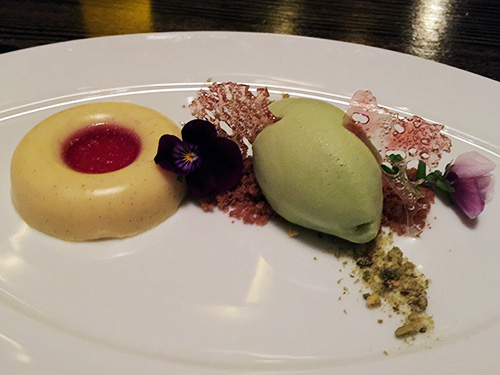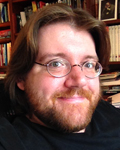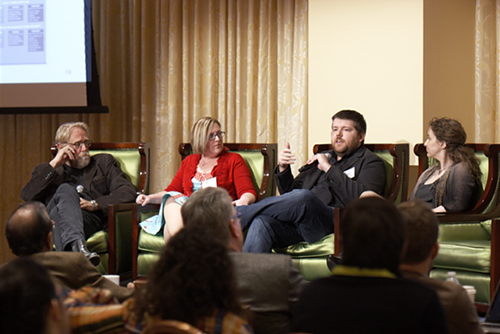I’m writing this first blog post of 2015 from a hotel room high in the Riviera hotel, overlooking the delightfully bizarre wonderland that is Las Vegas. I’m in town to participate in the equally delightfully bizarre wonderland that is the Consumer Electronics Show, checking another item off my personal bucket list. Yesterday afternoon my labmates from the Annenberg Innovation Lab and I gave a panel discussion at the Second Screen Summit, which was a huge amount of fun.
Here’s our panel description:
3 – 3:30 p.m.
Innovations in Storytelling & Media
The media and entertainment industry has become increasingly complicated as TVs and movie screens are joined by computers, tablets, and mobile devices. As wearables like Google Glass, virtual reality devices like the Oculus Rift, and smart objects, homes and cities are added to the mix, it’s time to ask: How do we best create, engage with and spread content when everything becomes a screen? Researchers and directors from the University of Southern California’s Annenberg Innovation Lab will share how storytelling and media will change in the next 3-5 years, including how storytelling and play will evolve through smart toys linked to transmedia worlds, the new opportunities and challenges of virtual reality and immersive media environments, and the potential of wearables as the next frontier for media and entertainment.
Moderator:
Prof. Jonathan Taplin, Director, Annenberg Innovation Lab, USC
Panelists:
Geoffrey Long, Technical Director & Research Fellow, Annenberg Innovation Lab, USC
Erin Reilly, Creative Director & Research Fellow, Annenberg Innovation Lab, USC
Francesca Marie Smith, Provost’s Fellow & Doctoral Candidate, Annenberg Innovation Lab, USC
The panel went very well, and afterwards Kevin Murphy – the showrunner of Defiance – complimented me on what I said up there. As a fan of his show and his work in the transmedia space, I blushed all the way down to my socks. That was a very good day.
365 Good Days
Good days are something I plan to focus more on in 2015. The end of 2014 was, quite frankly, really awful. Not only did one of my best friends on the planet pack up and leave LA, but my grandfather suffered a stroke on Christmas Eve, spent the following week fading away in the hospital and then finally passed on New Year’s Eve. That one-two punch really clarified two things:
- life really is short, so make the most of it every day
- every day can be a good day if you work to make it so and focus on the good stuff
They may be psalms from the Hallmark Card school of wisdom, but that doesn’t make them any less true. So, one of my big 2015 New Year’s Resolutions is to focus on the positives, and to grab reality by the lapels and make it better. I’ve been privately practicing the “365 Good Days” exercise, where you take a little time and write down the good things that happened each day, but I’ve also been working with a renewed vigor to make each day as awesome as possible. We’re almost a week into 2015, and I’ve connected more with my family, enjoyed some mind-blowingly amazing food (yes, Erin and Francesca, the pop rocks sushi at Yellowtail at the Bellagio was unlike anything else I’d ever had before, but the High Steaks [sic] roll and the vanilla white chocolate cherry mousse were two of the best things I’ve ever tasted) and even been more productive.

vanilla white chocolate cherry mousse from Yellowtail
To that end, I’d like to share here part of a Statement of Purpose essay I had cause to write late in 2014. I’ve been thinking a lot about the phrase “The Future of Storytelling” and how it can function as a multifaceted structure for my work, and what I’m passionate about, and I think I’ve struck upon something really useful for all of this thinking along these lines.
A (Re)statement of Purpose: On the Future of Storytelling
Let me tell you a story.
I was the only kid of an only kid, growing up in a pre-Civil War farmhouse out in rural, middle-of-nowhere Ohio. Not only did I not have any siblings, I didn’t even have any neighbor kids within walking distance for years. What I did have, however, were brilliant, creative, generous parents who must have believed that the second best thing to siblings were stories. Our house was always packed with books, including the myths, adventure stories and Classics Illustrated comics that my grandparents had given my mom when she was a little girl, and I would lose myself in those tales for hours. Meanwhile, my Dad would smuggle reams of copier paper out of his office and home to me, and I would joyfully fill them up with stories and drawings of my own.
This blend of solitude, stories, and supplies was the perfect recipe for making a highly creative (if admittedly slightly weird) kid. Not only would I write and illustrate my own stories, but Dad and I would go into his office after hours, run off a pile of copies on their Xerox machine, and then hand them out to all my elementary school friends the next day. Before long my friends were making stories and art of their own, and I was happily bundling all our stuff up together into funny little proto-zines.
My fate was really sealed, though, the day Dad brought home not paper, but an Apple II computer.
Keep in mind that this was the early 80s, so this beastie was a beautiful, monstrous contraption that whirred and clunked and flickered tiny, blocky green letters across its TV-like, bulbous, black screen. At first I didn’t know what to make of it, but then I discovered what I could make with it: stories, and new kinds of stories at that. Now I could create stories that asked the user what they wanted to do, and make images that moved! I taught myself just enough BASIC to build my own crude interactive fiction pieces, illustrated with equally crude ASCII art. It was my favorite toy, right up until my Dad brought home something even stranger: a second computer, but one with the monitor, the disk drive and the CPU all fused together into one blocky chassis. It was the first time I’d laid eyes on a Mac, with its wonderful little mouse and its glorious Graphical User Interface. A few years (and a few computers) later, I was exploring mind-blowing games like The Fool’s Errand, The Manhole and Myst, and using equally mind-bending tools like PageMaker and HyperCard to create even cooler zines and interactive storyworlds of my own. This co-evolution of storytelling and technology would become the recurring theme of my life.
My crude little zines grew into Inkblots, a full-fledged “literature, culture and technology” zine I created for my creative friends at my high school, our friends from other schools across Ohio, and, once I discovered AOL, other similar-minded kids from around the world. I went on to earn my bachelor’s degree from Kenyon College, complementing my time in its presitigious creative writing program with endless hours geeking out in an experimental proto-digital humanities program where, instead of traditional papers, I created things like CD-ROMs and QuickTime VR experiences. After graduation I landed a job as a graphic designer for a medical best practices research firm, where I quickly became their first web designer and then web producer. That led to my starting up my own digital design and copywriting consulting company, and I began producing short films in my spare time with my friends. After a few years of that, I was fortunate enough to be accepted into the Master’s program in Comparative Media Studies at MIT, one of the most transformative experiences of my life.
At MIT I studied under Henry Jenkins, researching the emerging aesthetics of transmedia storytelling (in which stories are strategically crafted to unfold across all kinds of traditional and new media) and I helped co-found both the Convergence Culture Consortium and the Singapore-MIT GAMBIT Game Lab. My work in transmedia storytelling and video games got me drafted by Microsoft, where I would spend a few years first as a member of a “future of media and entertainment” think tank under the company’s CTO/CXO (where I had a hand in the creation of both the Xbox One and SmartGlass) and then as a cofounder of the Narrative Design team (where we worked to create vast storyworlds the size of Halo that would unfold across Microsoft’s entire entertainment platform, including those screens that don’t exist yet). After leaving Microsoft, I followed Professor Jenkins down to USC, where I now serve as the Technical Director and a Research Fellow for the Annenberg Innovation Lab. Even now, I’m still following the same theme of weaving together storytelling and new technology, exploring how stories might be told with such “new screens” as 3D printers, virtual reality, augmented reality, connected homes, connected cities, wearable devices, the Internet of Things, and so on – but now I’m also studying how technological disruptions in the Media and Entertainment industry change how storytellers make a living.
“The Future of Storytelling” almost perfectly sums up my life so far, but it also nearly perfectly encapsulates what I’m trying to do moving forward. It’s my driving purpose as a storyteller, a technologist and an educator, depending on which part of the phrase you emphasize.
- The Future of Storytelling. Storytellers become hyper-aware of how stories and culture impact one another. Humans have always used stories to pass along knowledge, to share techniques for survival and for better understanding the world around us. As things both change and stay the same, so too do the stories we tell each other. What are the lessons, both timely and timeless, that we will need to share? How does an increasingly globalized culture change what cultural tales we share and enjoy? What new fears and hopes will lead to new stories? What new storyworlds will capture imaginations so completely that they become philosophies, reshaping the world? What are the stories that we will want to tell and be told?
-
The Future of Storytelling. Much as I discovered when I first laid hands on a computer, the tools we use can shape the kinds of stories we can tell. Old media never go away – video never did completely kill the radio star – but new media do create new opportunities. Further, some storytellers have such creative visions that they need to invent wholly new media to realize them. How do the media we use to tell our stories shape the stories themselves? What kinds of stories lend themselves particularly well to certain media like books, comics, movies, TV shows or video games? What kinds of stories can now be told using such “new new media” as smart objects, wearable devices, 3d printers, ubiquitous computing, or virtual reality? How will the ways in which we tell stories change?
-
The Future of Storytelling. Perhaps most importantly, who will be the next generation of storytellers? What skills will they need? How will traditional storytelling, worldbuilding and media-making techniques combine with new forms of artistry to create wholly new, even revolutionary works of art? How will these new creators and makers find their audience, in an age of content supersaturation? What new business models and practices will they need to embrace to not just survive, but flourish? Who will teach this next generation of storytellers, and what will they need to be taught?
My daughter is, at least as of this writing, also an only kid. Every day I try to pass on to her the same love of stories, art and creativity that my parents instilled in me. My dream is to do the same for as many others as possible, continuing my own experiments and explorations into the future of storytelling and sharing what I create and discover. My eventual goal is to practice, consult and teach, founding a Future of Storytelling Laboratory or Workshop where likeminded storytellers can come together to collaborate on even bigger, more valuable and more meaningful innovations and works than any of us could do alone. I deeply believe that, to paraphrase both Abraham Lincoln and Peter Drucker, the best way to predict the future of storytelling is to create it.
So that’s what I’m working so hard to do, in 2015 and beyond. Happy New Year, everyone, and may all of us enjoy 365 good days this year!



